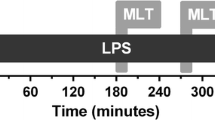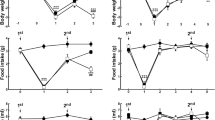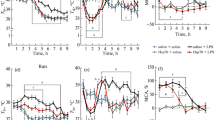Abstract.
Injection of a high dose of lipopolysaccharide (LPS) induces a septic-shock-like state, which can be accompanied by phases of hypothermia and phases of fever. In the present study we monitored body core temperature and locomotor activity, both by remote radiotelemetry, as well as changes in food intake, body mass and water intake for 3 days after an intraperitoneal (i.p.) injection of a high dose of LPS (5 mg/kg) along with sterile 0.9% saline or a neutralizing form of the soluble tumor necrosis factor (TNF) type 1 receptor (referred to as TNF-binding protein, TNF bp). Intraperitoneal injection of LPS rapidly induced high concentrations of TNF in the plasma and peritoneal lavage fluid. TNF was undetectable in the plasma and peritoneal lavage fluid of animals co-injected with LPS and TNF bp, implying neutralization of peripheral bioactive TNF. Administration of LPS induced hypothermia by about 1.5°C, which lasted for 5 h after injection. During the light-time periods of days 2 and 3 after injection, the rats developed a robust fever. Treatment with TNF bp resulted in a faster recovery from the LPS-induced hypothermia so that the rats developed a pronounced fever on the day of injection. Locomotor activity during night-time periods was suppressed in LPS-treated animals. The LPS-induced depression of night-time activity was not antagonized by co-injection of TNF bp. On day 1 after the injection of LPS, food intake reduced to virtually zero, water intake fell to about 30% of the control value and body mass dropped by 25 g (about 10% of total body mass). With the exception of body mass, these variables recovered slowly during days 2 and 3 after LPS injection, but did not reach the control values. The LPS-induced decreases in food intake, body mass and water intake were significantly attenuated by the treatment with TNF bp. These results confirm that TNF contributes significantly to the rats' responses to intraperitoneal injection of a high dose of LPS. The fact that treatment with TNF bp accelerated and improved the rats' ability to develop a febrile response supports the view that the fever is beneficial, since all other metabolic responses measured in this study were normalized more effectively in those rats that developed a faster and more pronounced increase in body temperature.
Similar content being viewed by others
Author information
Authors and Affiliations
Additional information
Received after revision: 8 April 2000
Electronic Publication
Rights and permissions
About this article
Cite this article
Töllner, B., Roth, J., Störr, B. et al. The role of tumor necrosis factor (TNF) in the febrile and metabolic responses of rats to intraperitoneal injection of a high dose of lipopolysaccharide. Pflügers Arch - Eur J Physiol 440, 925–932 (2000). https://doi.org/10.1007/s004240000386
Received:
Accepted:
Issue Date:
DOI: https://doi.org/10.1007/s004240000386




